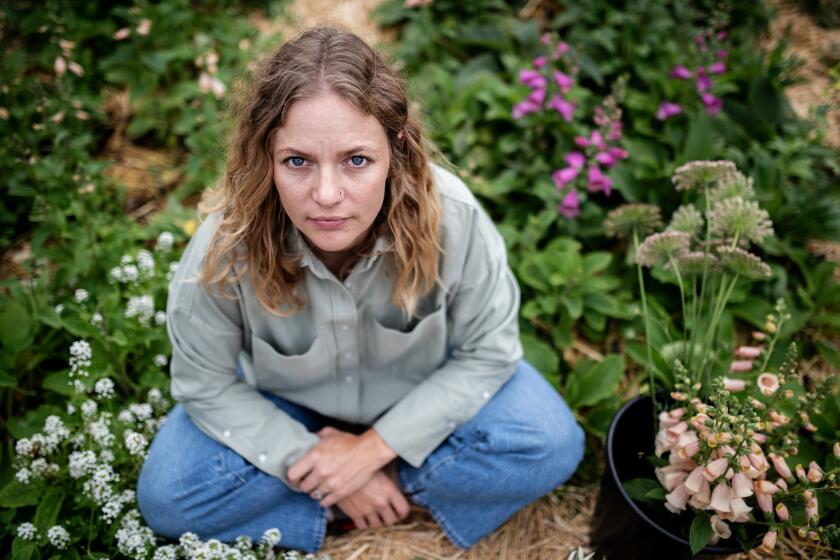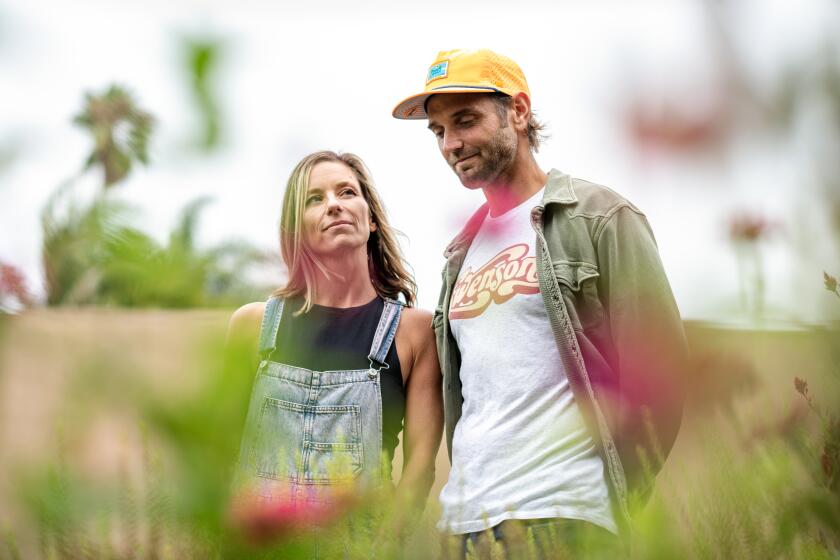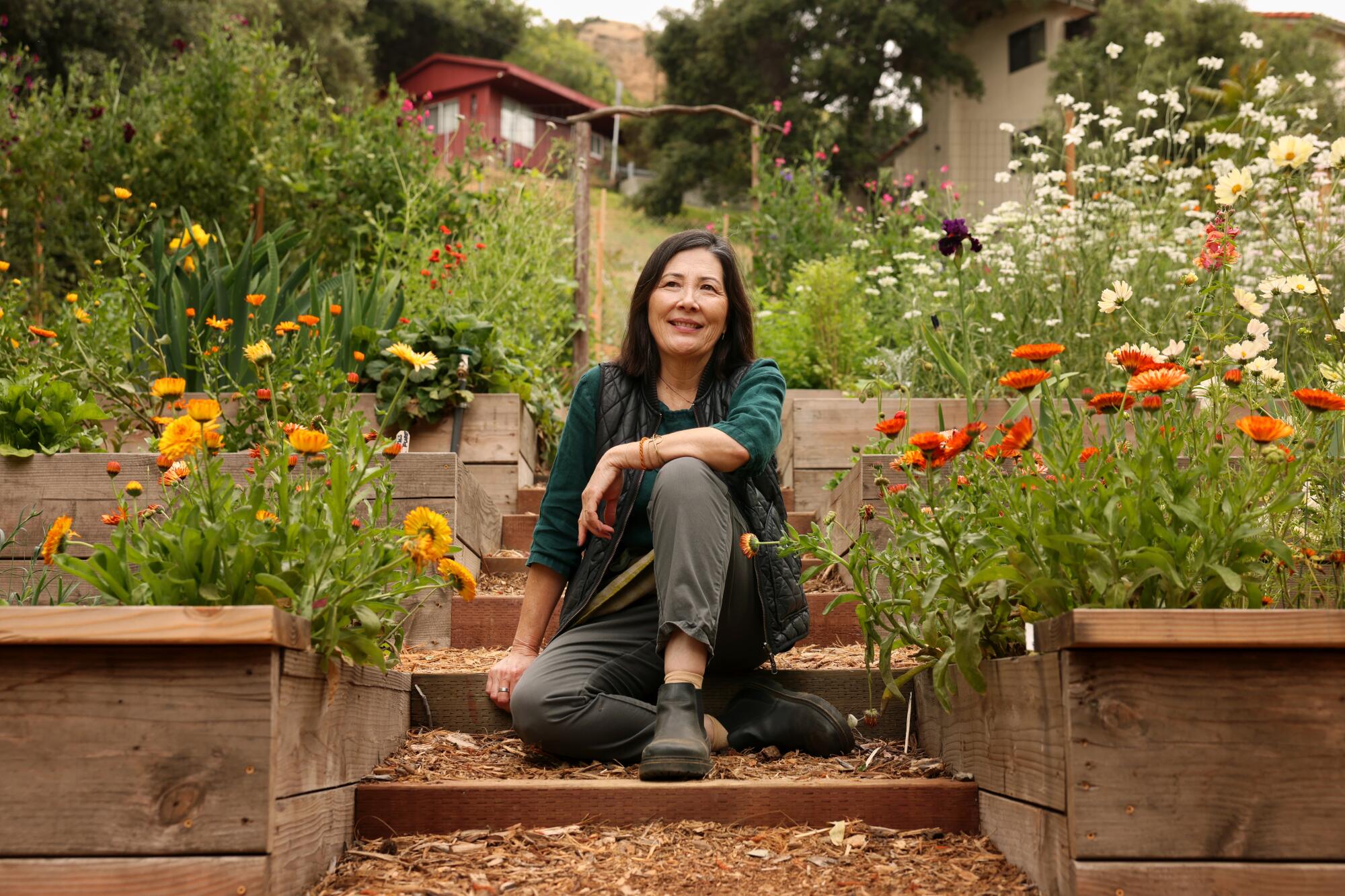
- Share via
Kathleen Ferguson grabbed a pair of pruning shears from a mailbox nailed to a garden bed and leaned down to cut bunches of Orlaya grandiflora on the flower-filled hillside.
“This property has a pulse,” she said as she placed the white lace flowers into a bucket of water. “The wildlife is incredible here. I’ve caught bees napping in the sunflowers.”
For the record:
1:45 p.m. June 4, 2024Lauri Kranz’s L.A. Homefarm is in Glassell Park, not Highland Park as originally stated.
With limited land for green space in Los Angeles, many people are growing flowers for sale in surprising places — under power lines and in their front and back yards. In Ferguson’s case, the landscape designer is propagating flowers on a vacant lot offered by a friend, screenwriter Dalan Musson, whom she met while volunteering at the North Central Animal Shelter in L.A.
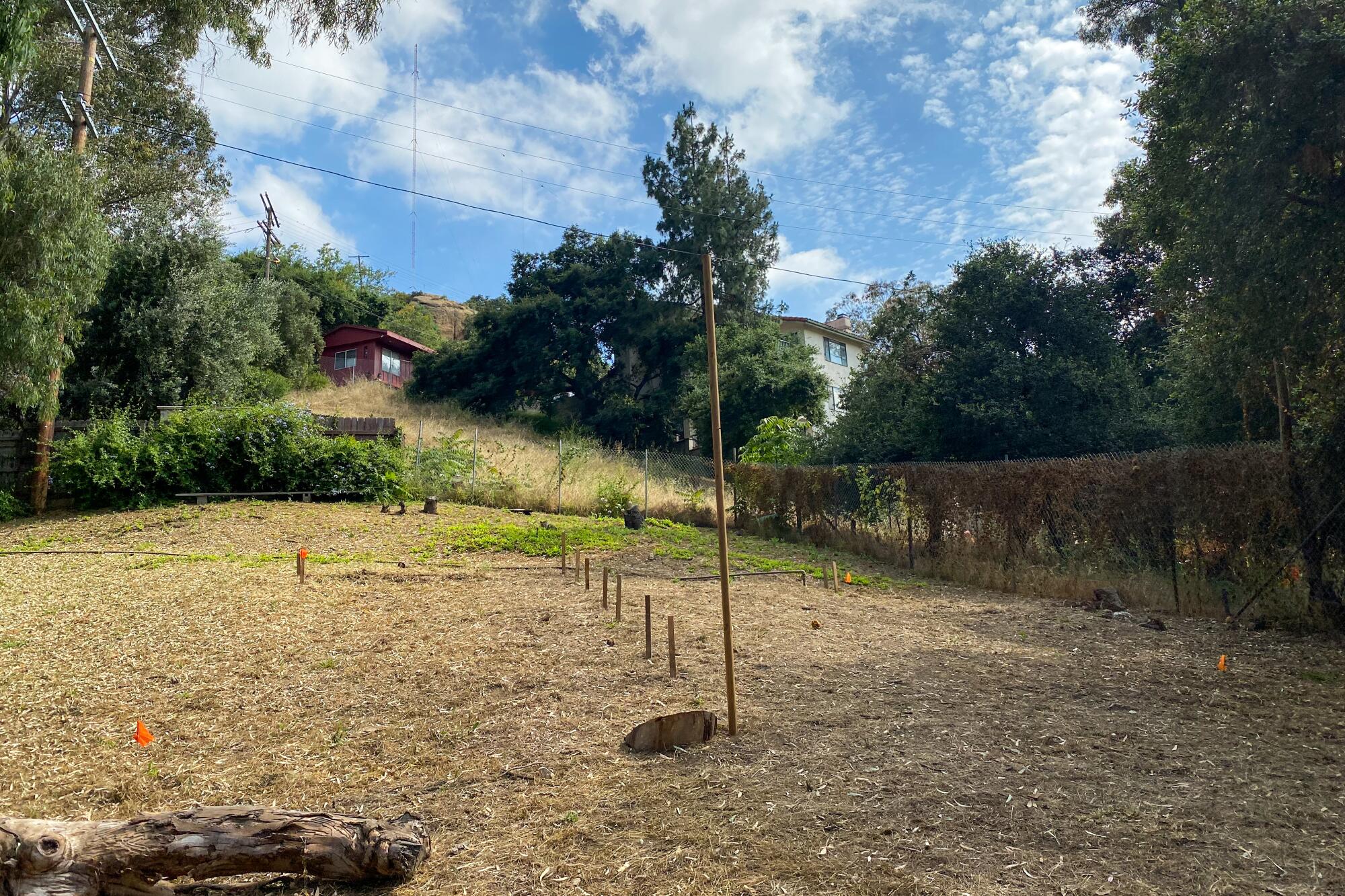
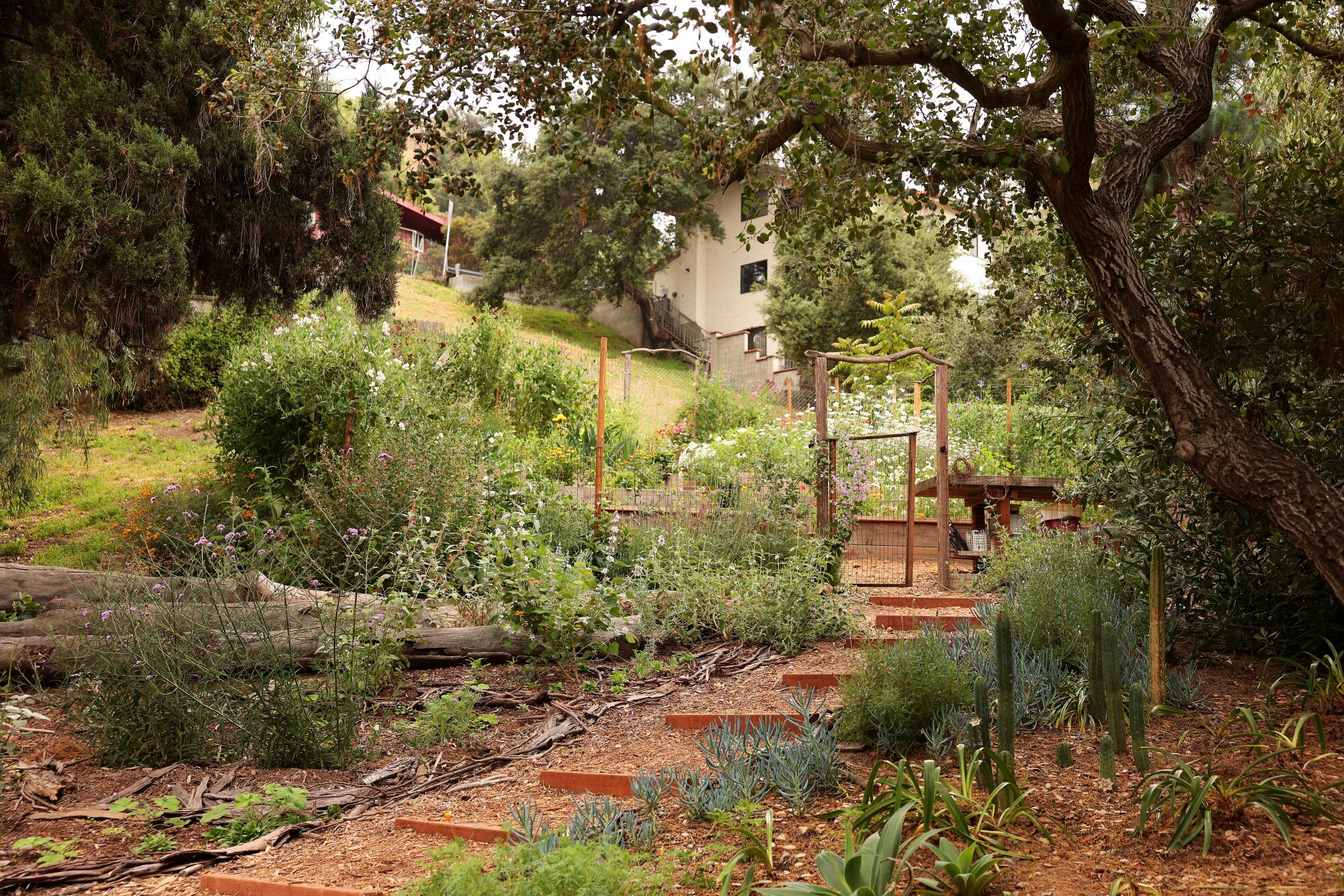
“Just being able to walk outside and see monarch butterflies and bees flying around my backyard is amazing,” Musson said of Frogtown Flora’s effect on the wildlife on his 1.5-acre property in Eagle Rock. “It makes me feel viscerally connected to the natural world.”
It’s magical for Ferguson too, who over the last 11 months has built a colorful farm on the half-acre with flowers, including Agrostemma, irises, zinnias, cosmos, roses, sunflowers, sweet peas, French dianthus and ranunculus. White marigolds and green onions are planted to help deter the skunks, raccoons and squirrels that like to pull out her dahlias. Volunteer tomatoes and cilantro that materialized from the compost are left to bolt and blossom. “I like to mix it up,” she said of the variety of plant life. “If something comes up, I’m OK with letting it grow.”
During the pandemic, Rachel Nafis worked as an ER nurse. Burned out, she turned to flower farming and learned that being a florist is about more than just flowers.
Outside the farm’s perimeter and at the top of the hillside, she is experimenting with drought-tolerant California native perennials, including fragrant pitcher sage, buckwheat, mallows and the native rose Rosa Californica. She also grows native poppies — Matilija and California — penstemons, lupines and many different salvias.
Like many landscape designers used to working outdoors, Ferguson struggled with cabin fever during the COVID-19 pandemic. When she began listening to podcasts about locally grown blooms while tending to her own garden, she became “obsessed with flowers.”
“I would listen to podcasts all day long, ‘On Being,’ ‘Slow Flowers,’ ‘Cultivating Place’ and [‘Field & Garden’ from the Gardener’s Workshop] among them,” she said. She was struck by the environmental impact of imported flowers related to pesticides, water and shipping, and her journey into urban flower farming was a natural progression. With a degree in horticulture from Cal Poly Pomona and a passion for the environment, she decided to grow what she describes as “climate-appropriate flower species” for Los Angeles.
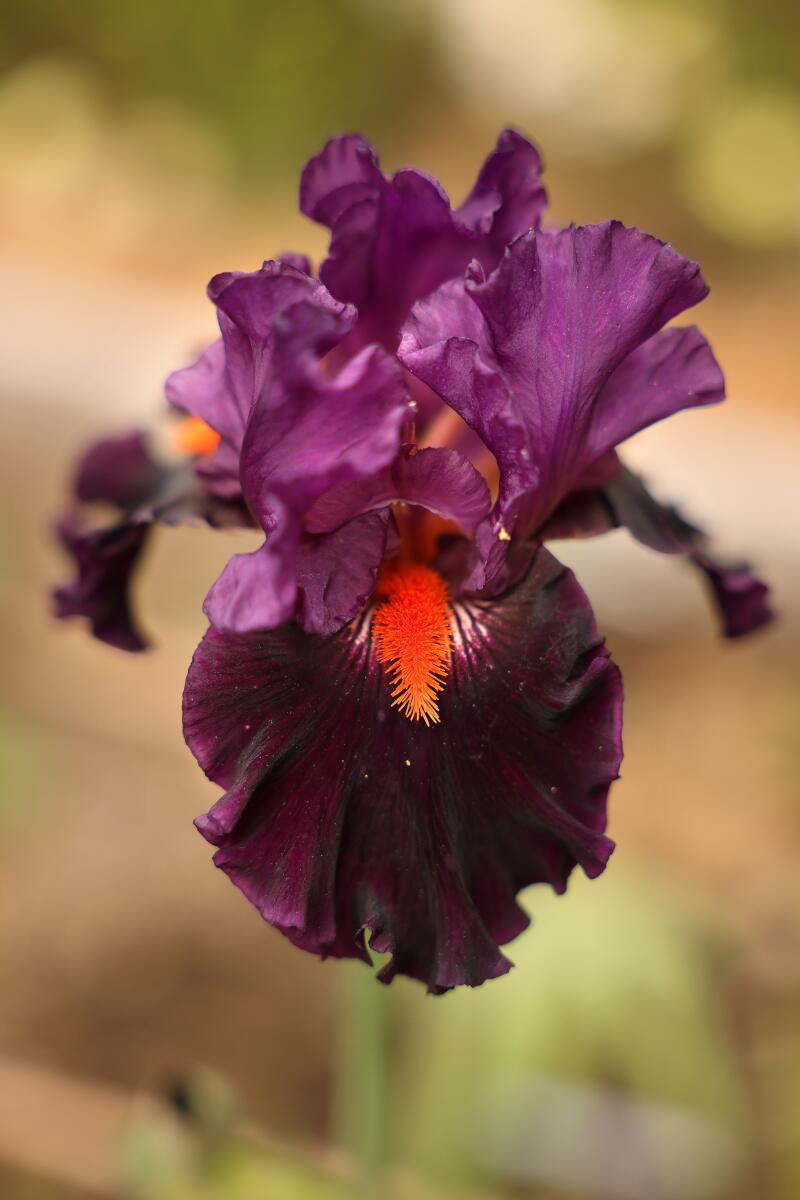
A Sharp Dressed Man iris in Ferguson’s garden.
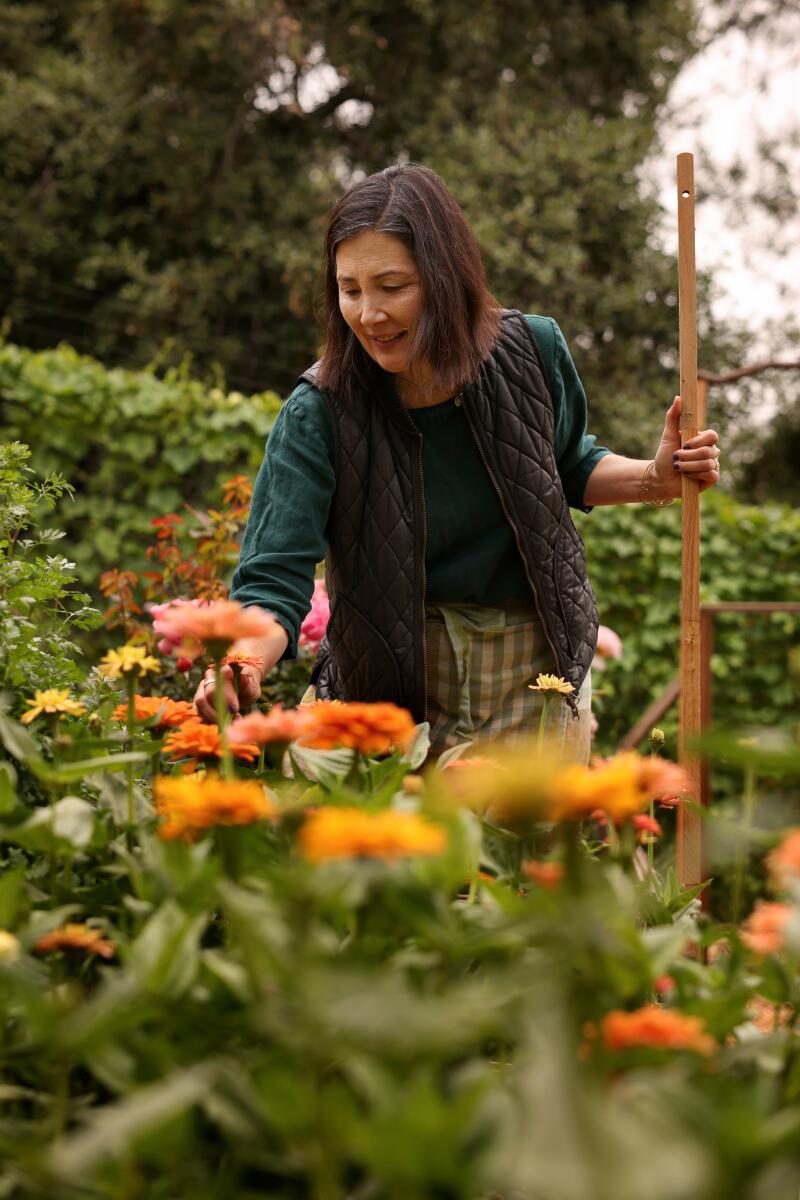
Ferguson tends to her flowers.
She learned a lot from the local flower growers she contacted on Instagram: “I noticed that all of the flower farmers, who happened to be women, are so passionate about what they do and so generous with their knowledge. I can reach out to any of them and ask, ‘What has been your experience with germination?’”
The flower growers hosted rotating potlucks at their farms and attended the San Fernando Valley Iris Society, of which Ferguson is a member.
Her first venture was a small plot at Jardin del Rio on Riverdale Avenue in 2022. But as her interest and knowledge grew, so did her ambitions. When Musson listened to how passionate she was about growing flowers locally, he offered a portion of his property as a new canvas for her urban flower farm.
“People are good,” Ferguson said of Musson. “People are generous; they want to help others realize their dreams. It’s a win-win for both of us.”
The challenge for Ferguson was the site. “I was excited,” she recalled, “but when I saw it was a slope, I knew it would be a lot of work.”
Chad and Stacie Vanags’ backyard cutting garden has become a healing sanctuary for the couple and others, following Chad’s Stage 4 lung cancer diagnosis.
Once she understood how it might work, she built 12 4-by-10-foot raised beds on either side of a stairway with wood left over from a construction project at her house.
“My husband and I loaded the wood in a truck and brought it here,” she said. “Now, when I get extra wood, I can’t help but think about what I can grow here. We’re going to put in a greenhouse and add more beds. Everyone my age is into Pilates and strength training, and when they suggest I go, I tell them, ‘Do you know how much strength training I do on this slope?’”
Ferguson’s good luck continued when she realized the soil didn’t need a lot of work because the land had never been developed. “We used what was here,” said the designer and certified arborist, who avoids chemicals. She started with a weed barrier, on-site soil, worm castings, compost and organic fertilizer. She tops the soil with her rabbits’ bedding when it’s time for it to be replaced and has been experimenting with sheep pellets to enrich the soil and help deter slugs, snails and weeds. She installed a drip irrigation system and pays Musson monthly for water, although she said she doesn’t use much. “The natives don’t require any once established,” she added.
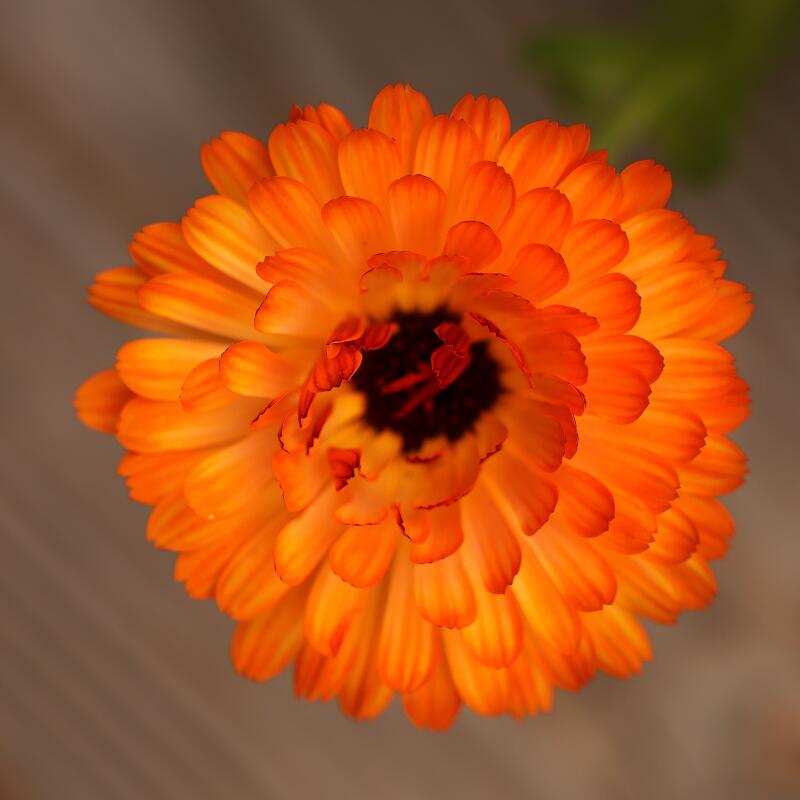
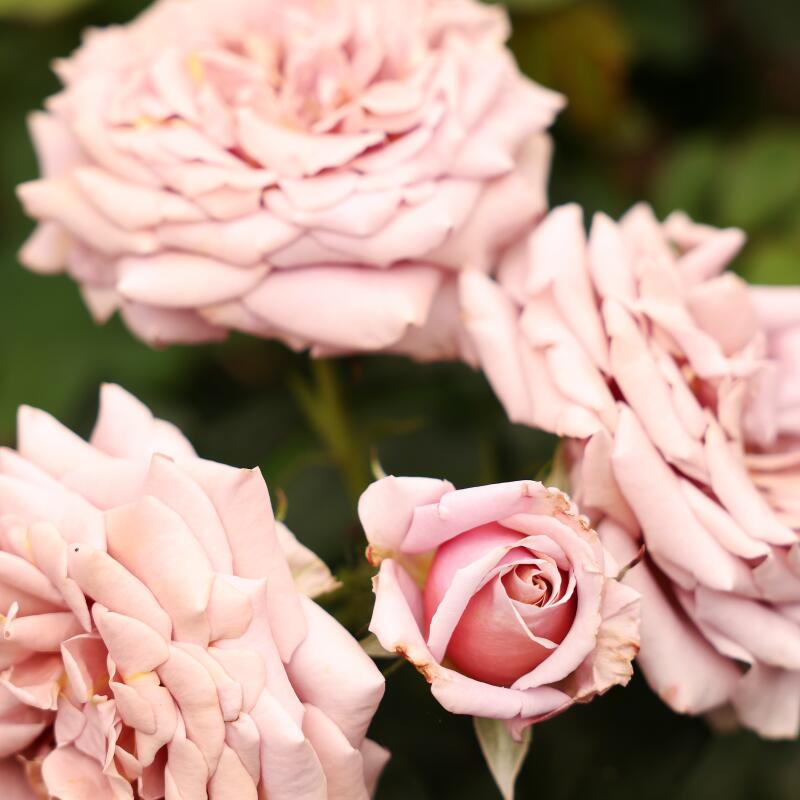
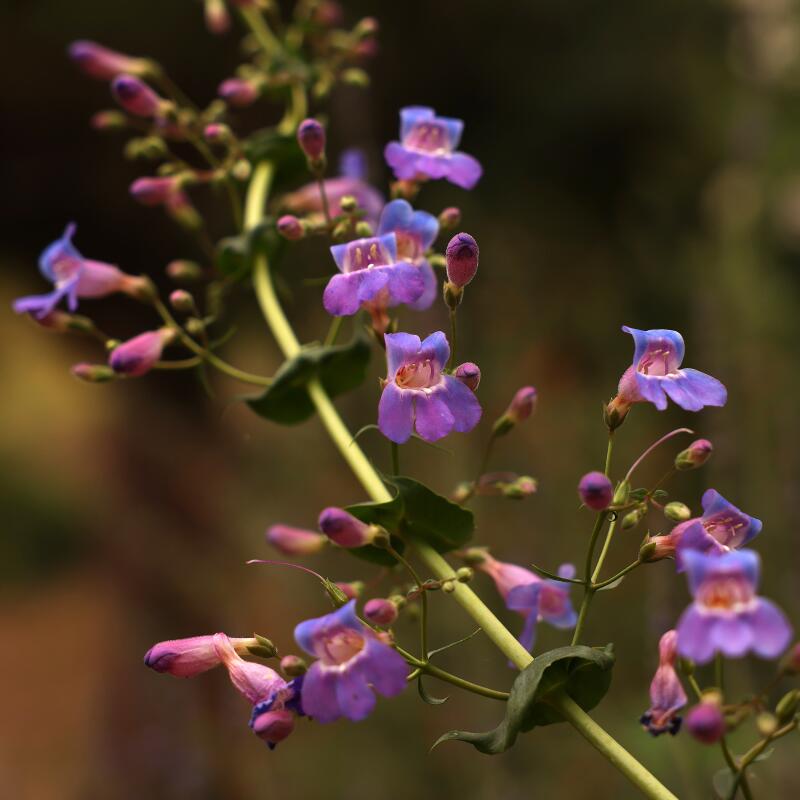
Calendula. Koko Loco roses. Penstemon.
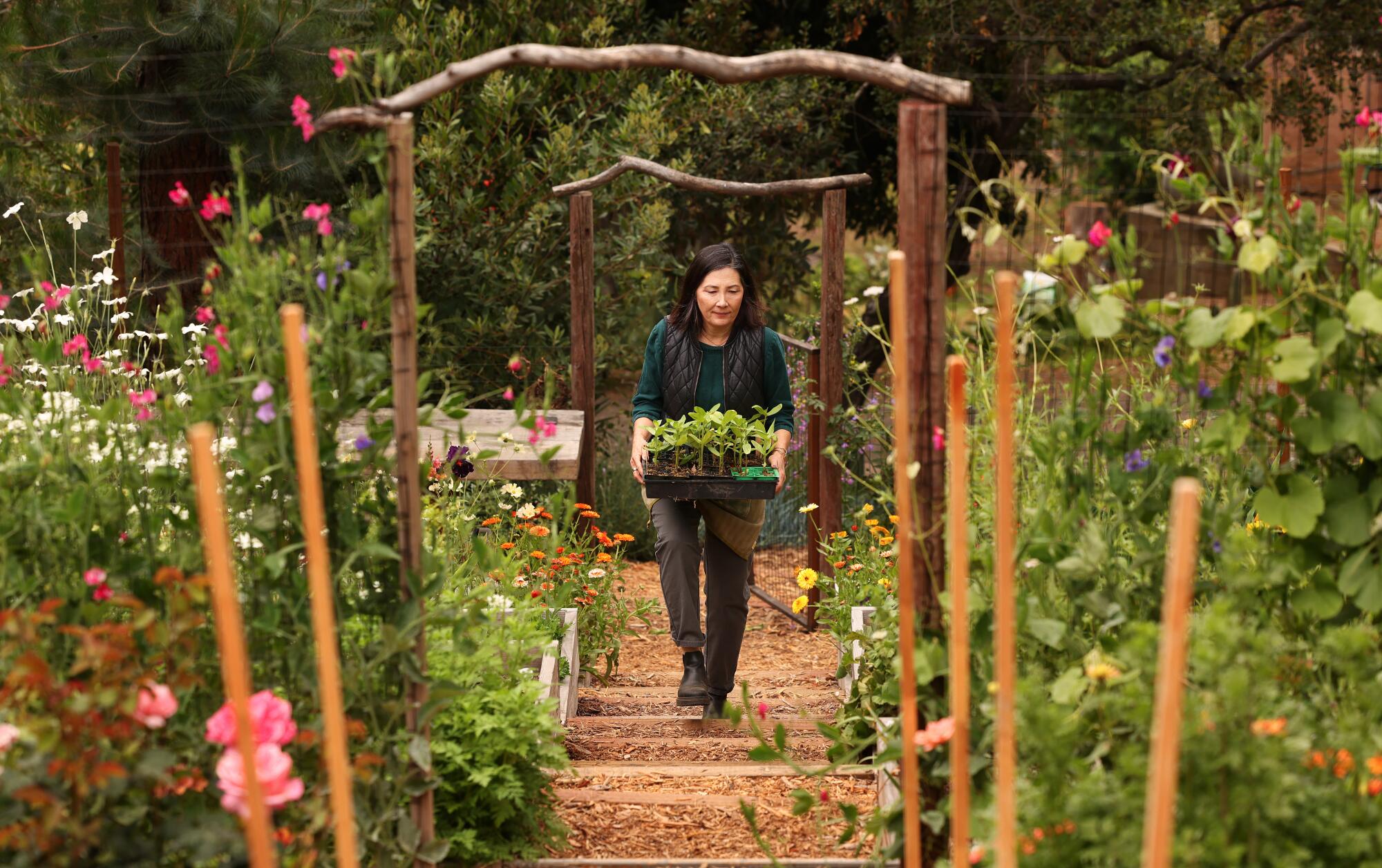
She is a big fan of using rabbit waste as fertilizer because it doesn’t require composting like chicken manure.
“Rabbit poop is amazing and so good if you are trying to close the loop in your garden,” she says, “as you can feed them a lot of greens, and then what they produce goes straight into the garden.”
While some farmers choose what is trendy, Ferguson prefers to plant flowers she likes. It’s a strategy that is working.
“Kathleen’s flowers are dazzling,” said Lauri Kranz, who sells Ferguson’s flowers at L.A. Homefarm in Glassell Park. “When Kathleen pulls up in her car with buckets full of just-cut flowers, our customers start making a line to pull from the bounty that awaits.”
For Ferguson, a Los Angeles native who grew up in Koreatown, flowers are about more than just beauty.
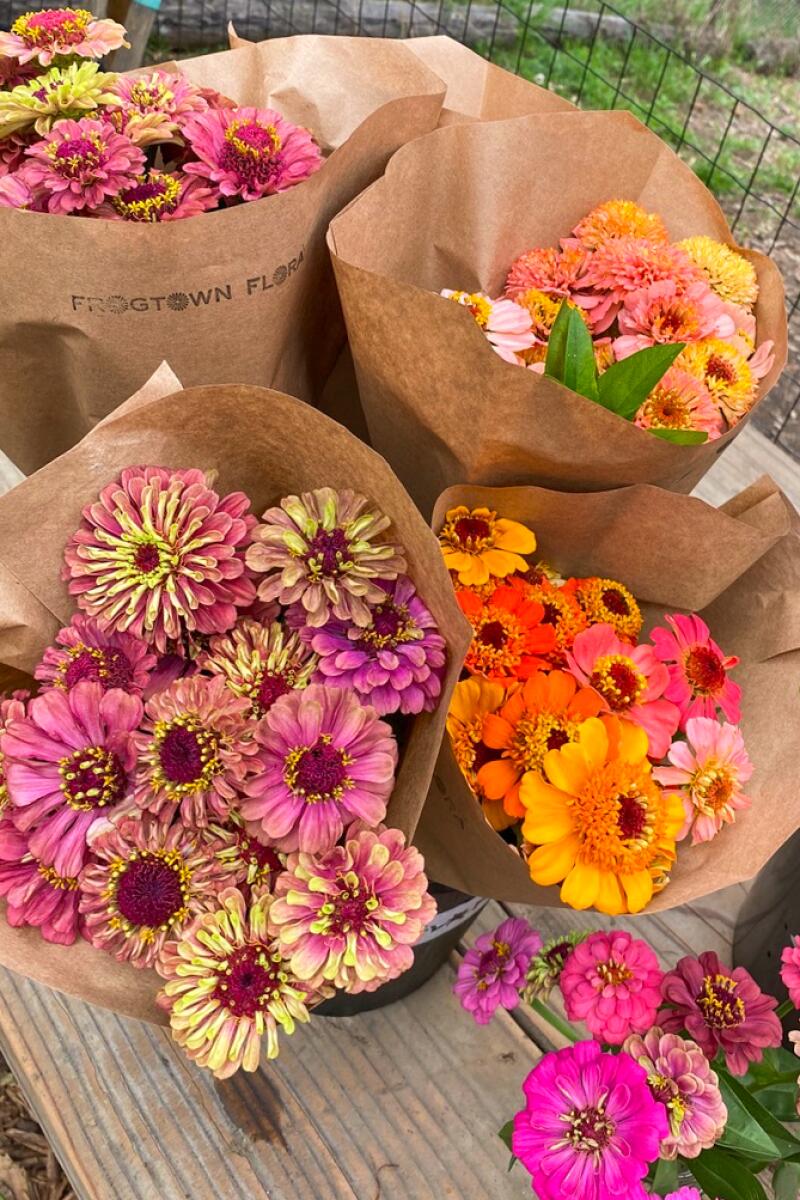
Frogtown Flora bouquets. (Kathleen Ferguson)
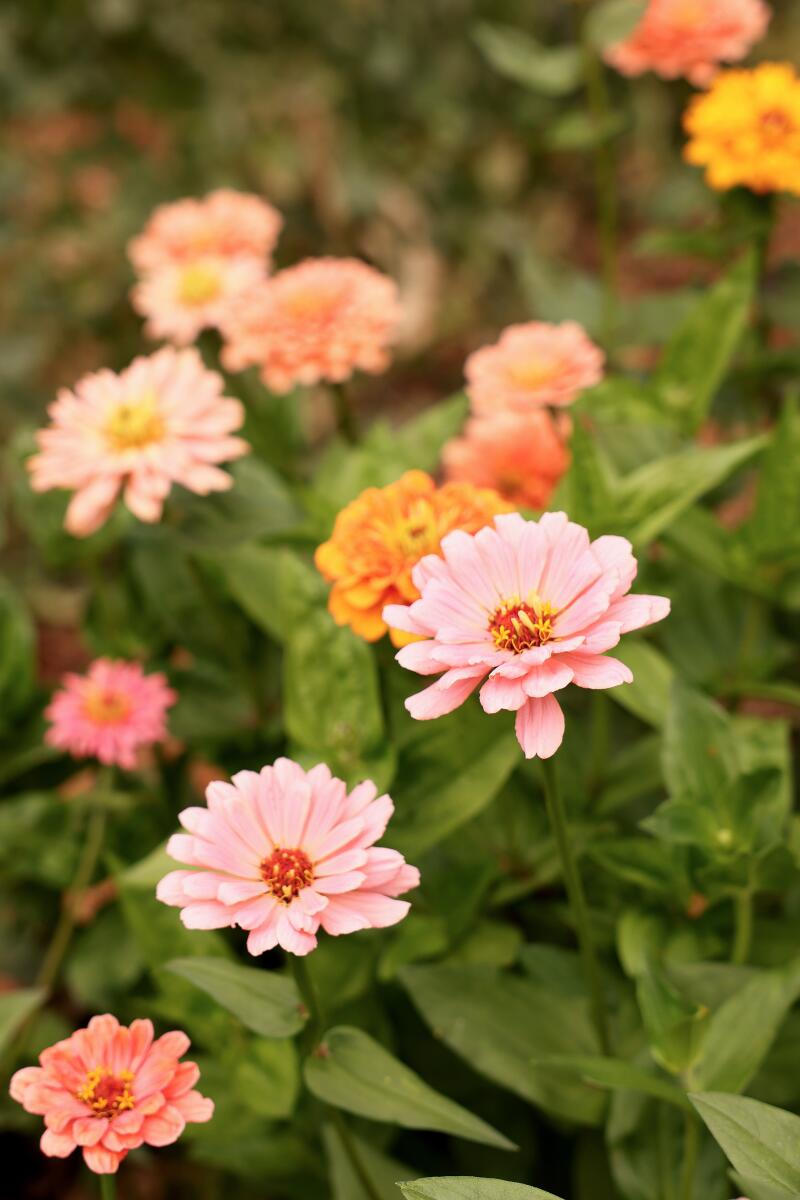
Zinnias in Ferguson’s garden. (Christina House / Los Angeles Times)
There’s the feel-good aspect. “It brings so much joy,” she said. “Flowers have been in our culture for as long as humanity. Flowers symbolize so many things. It’s the whole cycle of life. They mean so much to so many different cultures. I love growing. I love the challenge. I also love that I’m making people happy.”
And then there’s the wildlife aspect.
During a recent visit, the contrast between the roar of the nearby 2 Freeway and the sound of birds chatting in the garden was startling. Over in a dense patch of sweet peas, Ferguson pointed out an example of her “nature first” philosophy in the way she strategically cut the flowers to preserve the privacy of a bird’s nest. “The flowers have brought so much additional life to this property,” she said. “I leave that section of sweet peas alone.”
Native plants don’t just provide color and habitat in our yards, they also create beautiful, long-lasting, fragrant bouquets with the right preparation.
In addition to selling flowers to Kranz and Gather Flora at the Original Los Angeles Flower Market downtown, Ferguson recently started bouquet subscriptions and organized a tour of eight flower farms in L.A. She expected 50 people to show up. “We had to shut down our reservations when it hit 800,” she said, noting the interest in locally grown flowers.
According to a 2023 National Gardening Assn. Survey, 63% of respondents indicated that locally grown blooms were important when purchasing cut flowers and arrangements, while 59% indicated that blossoms grown in the United States were important when purchasing cut flowers and arrangements.
Like the slow food and slow fashion movements, consumers want to know where their flowers come from, said Debra Prinzing, founder of the Slow Flowers Society.
“I think people want to engage more deeply with nature as an antidote to the general stress and chaos of life,” Prinzing said. “Locally grown flowers, like those from Frogtown Flora and other Southern California flower farmers large and small, provide the sensory connections we crave. They reflect the season, moment in time and location when we commemorate special occasions or everyday gestures.”
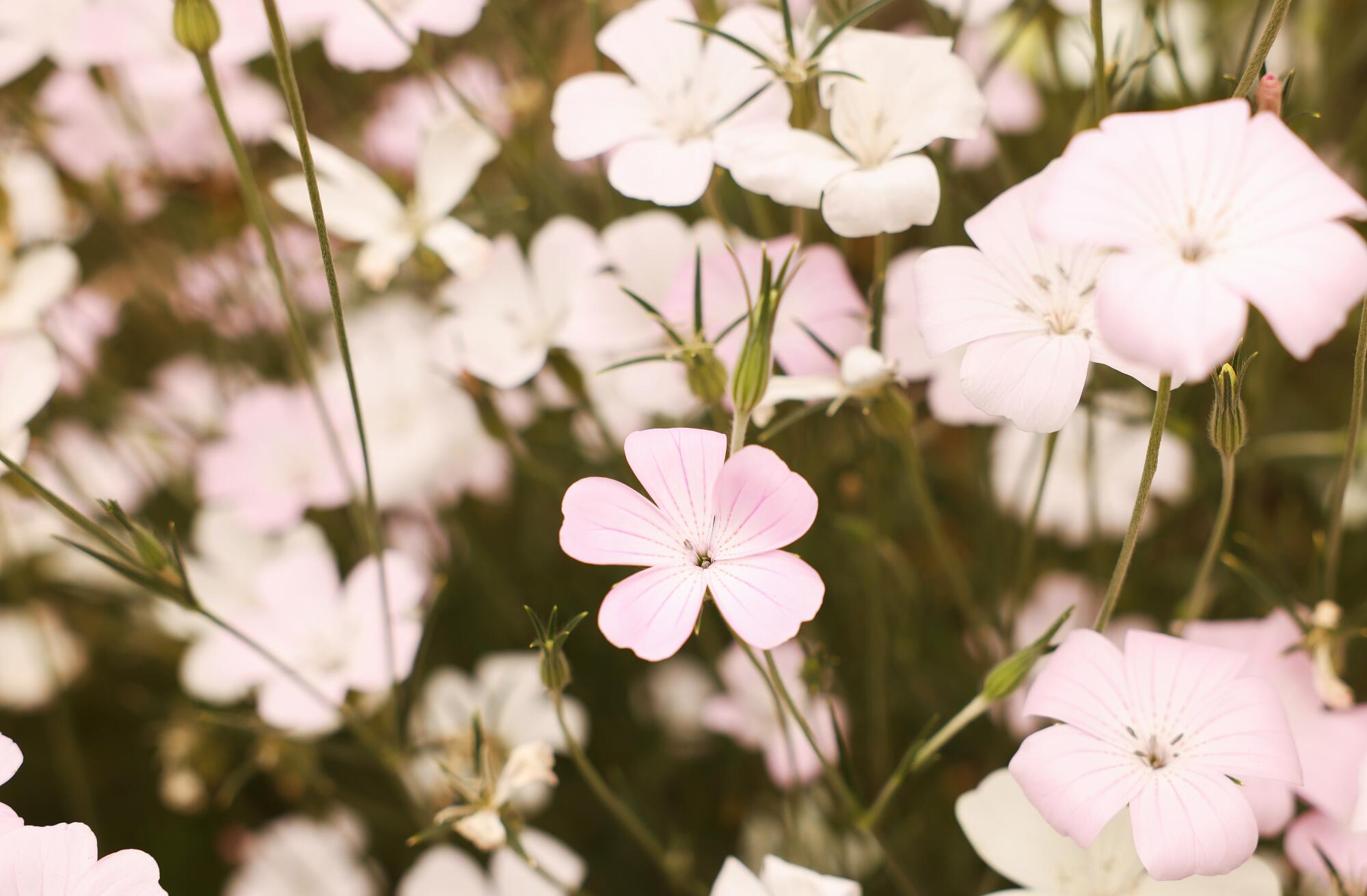
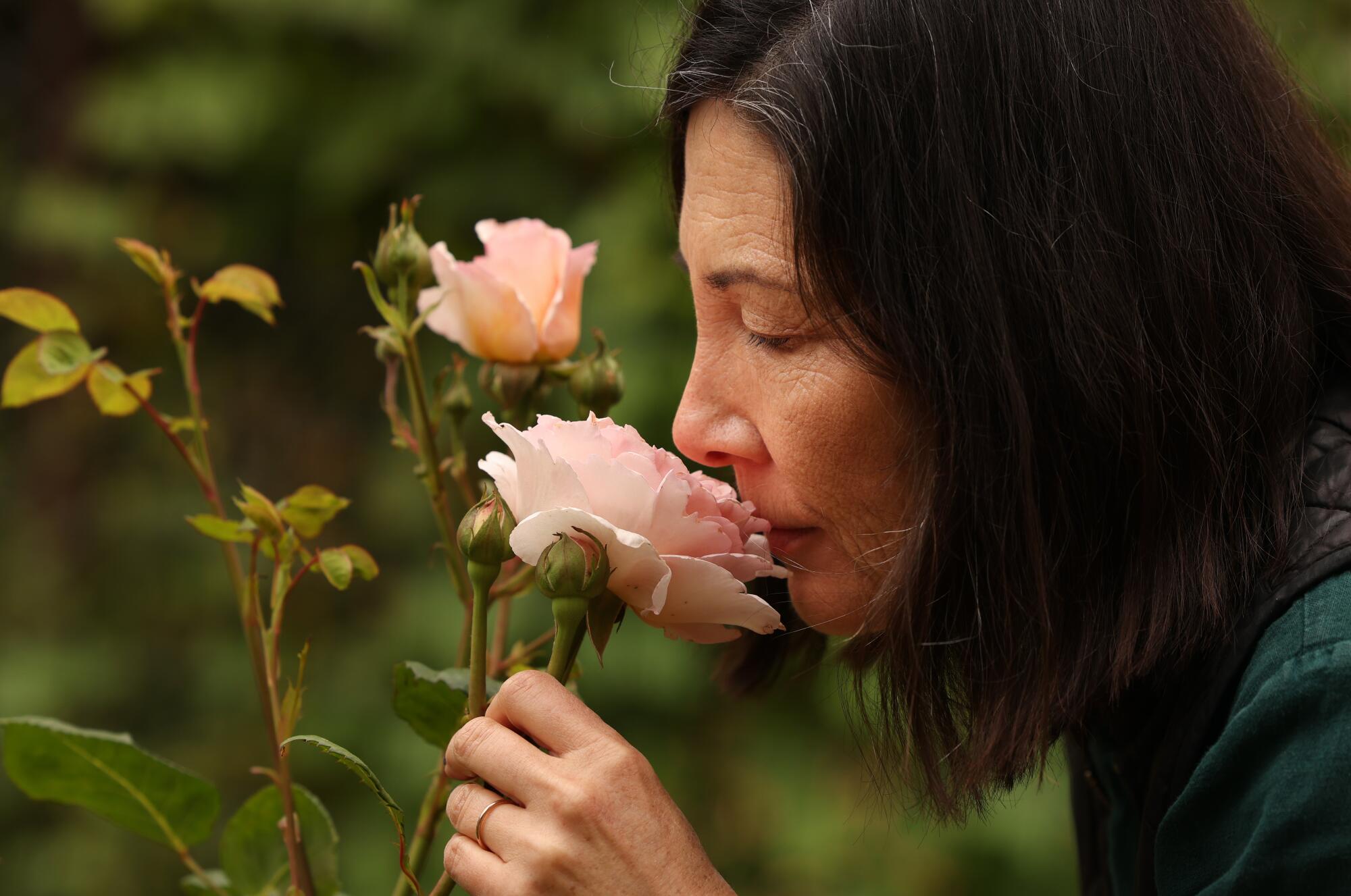
Ferguson, 55, also sells mixed vase arrangements and buckets of blooms to customers interested in fresh flowers but not necessarily a designed arrangement. “This is a great option for DIY weddings and celebrations and for those who just want beautiful, pesticide-free, fresh and locally grown flowers,” she said.
Walking up to the garden from the street along the long driveway, it’s clear why Musson is delighted with the plot’s transformation.
“Some days, when I’m exhausted, I’ll come up here and see a new flower that I’ve never seen before,” he said. “Sometimes I can’t believe I’m living in L.A. A Target is within walking distance, yet I have mature coastal live oaks, toyon and Catalina cherry trees. There are bats. I hear owls at night. ... It’s amazing to have a place for the bees and butterflies to go.”
More to Read
Sign up for The Wild
We’ll help you find the best places to hike, bike and run, as well as the perfect silent spots for meditation and yoga.
You may occasionally receive promotional content from the Los Angeles Times.
